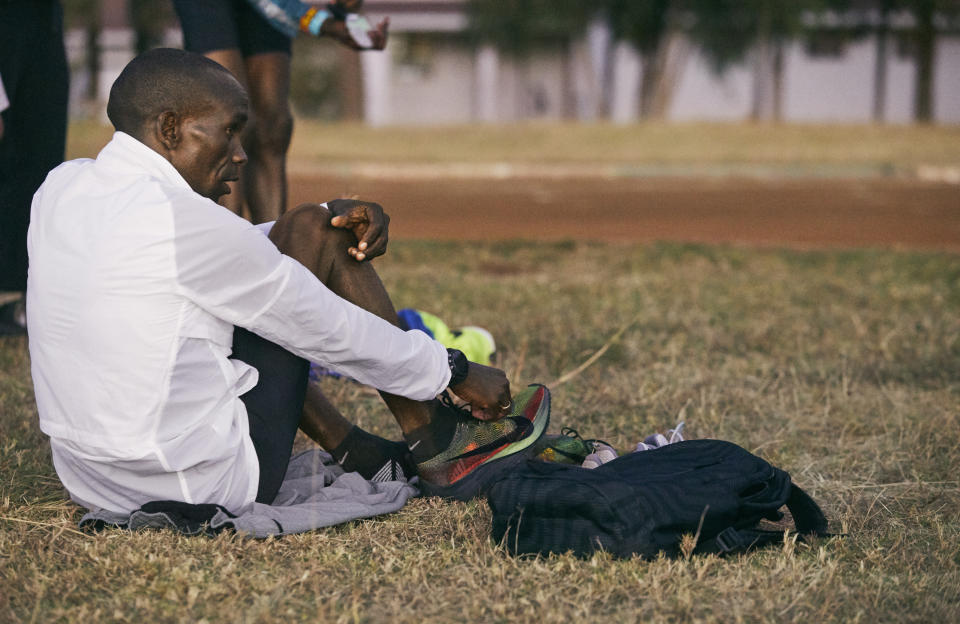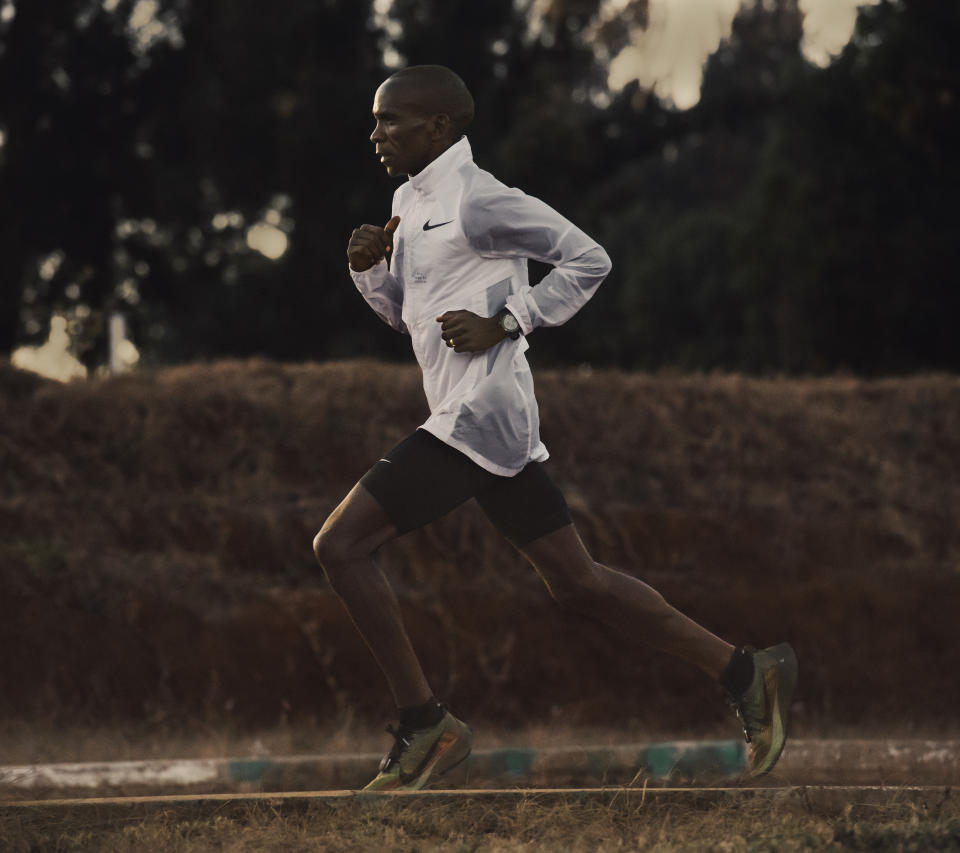Olympic gold medalist to debut 3D-printed shoes at London Marathon

Kenyan long-distance runner Eliud Kipchoge says his “main calling” in Sunday’s London Marathon is to set a new world record. And he’s going to do it in the most technologically advanced pair of running shoes ever made.
Kipchoge, 33, will debut the Nike Flyprint, the first-ever 3D-printed performance footwear, with textile uppers printed specifically to the shape of his foot and accounting for both the specifics of his running stride and his personal preferences.
With a stealth, black sole and a translucent, shimmery colorway that is reminiscent of the black, red and green of the Kenyan flag, the shoe weighs just 5.9 ounces or 169 grams. For comparison, when Kipchoge ran his 2:00:25 marathon, the fastest time ever, in Nike’s Breaking2 event in Monza, Italy, last May, he wore the Nike Zoom Vapor Fly Elite. (This race was assisted, with a pace car and supporting runners, and therefore does not count as a world record). That shoe, made with traditional machinery, weighed 180 grams.
Nike’s new 3D-printed upper is made on a printer re-engineered specifically to create shoes for performance, which means a softer, more customizable fit than other 3D running shoes. Information gathered from three-dimensional scans of Kipchoge’s foot strike over time is fed into the computer, along with Kipchoge’s personal feedback, to produce an upper that is unique to him.
The upper is printed layer by layer in a special blend of thermoplastic polyurethane (TPU) filaments, known for elasticity, transparency and resistance to abrasion and liquids. Each line is precisely laid down and fine-tuned to an athlete’s needs. Water resistance was especially important to Kipchoge, who ran a rainy Berlin Marathon last September and complained that his shoes became saturated and heavy. Monday’s Boston Marathon took place in a downpour, and weather conditions in London are often damp.
“This new shoe cannot absorb any water,” Kipchoge said. “So, it’s really a plus to me and to runners who will be running in some months when the weather is not really friendly.”
The TPU material, when laid flat, looks and feels like a more supple window screen, with patterns that vary from the forefoot to the heel and on the sides.
“The beauty of what we’ve done is in the details of the designs,” said Nike senior director of digital innovation Roger Chen. “We start with these thin line structures, then through Eliud’s feedback, we start fine-tuning it. Eliud wanted more lockdown in the forefoot, so we have a diamond pattern in the front for that, then it opens up into curves on the side for flexibility and breathability. You can see a lot more openings on the sides, and the lateral and medial sides are slightly different, because the foot isn’t symmetric. And on the heel, everything tightens back into that diamond structure again.”
The upper, which takes just 30 minutes to print, is attached to a sole made from two layers of ZoomX foam, known for its energy return and high resiliency, with a carbon fiber-articulated plate sandwiched in between.
“In combination, the foam and the plate amplify the athlete’s propulsion off the ground,” said Nike vice president of running footwear Brett Holts. “The foam gives the resiliency, the energy return, like a track spike, while the carbon fiber plate adds a level of stiffness and its shape actually, immediately upon impact, forces your foot to get up on the toe and off the ground more quickly.”
Kipchoge feels the difference in how his muscles respond to his most difficult training sessions.
“The shoes are really light,” he says. “And they absorb all the impact from the ground. When you run with this kind of shoe with all the efficiency inside it, to recover, it’s really fast. When you step on the ground, there is no impact at all, no soreness in the muscles.”
The process of printing the upper and attaching it to the already fabricated sole takes less than half a day. If not for the eight-day shipping lag between Nike headquarters in Beaverton, Oregon – where the 3D printer lives in Chen’s office – and Kipchoge’s training camp in Kenya, Kipchoge could conceivably go for a run in the morning, give feedback on his shoes immediately after, then go for a run that evening in a revised pair.

“Anecdotally, that’s pretty much what happens anyway,” Chen said. “Eliud is in Kenya training. He would take a piece of paper, sketch our design on it, then draw what he wanted to change and email it back to us. We would take that, redesign it and within hours we’re printing a sample. He’d get it nine days later, but the only bottleneck is the shipping.”
Nike runners Jordan Hasay, Galen Rupp, Mo Farah and Geoffrey Kamworor have also given feedback for their own Flyprint shoes. Chen says the athletes wanted similar shoe features when it came to lockdown, containment and flexibility, but that each definitely had their own preferences.
Rupp and Kipchoge, for example, like air to flow through their shoes, so the lattice weave on the sides of their shoes is much more open.
“Running with the Flyprint, the feeling is like you are flying,” Kipchoge said. “You feel the running all the way through you, the wind air across your foot, it’s like nothing else.”
If the casual runner is interested in trying Kipchoge’s airy Flyprints, there will be a limited number, made to Kipchoge’s specifications, available for $600 per pair on the Nike app after the London Marathon. All will be printed in Beaverton. And in the future, perhaps every one of those casual runners will have a customized, 3D-printed shoe.
“We are trying to always innovate and make great performance product even better based on athlete feedback and need,” Holts said. “We are really just doing what Nike does best.”
So Kipchoge can do his best. And, he hopes, the world’s best.
More from Yahoo Sports:
• Jeff Passan: MLB’s scary problem has nothing to do with weather
• Desiree Linden makes history with Boston Marathon win
• Angels ask fans to be quiet during Ohtani’s at-bats
• James Harrison announces retirement

 Yahoo Sports
Yahoo Sports 